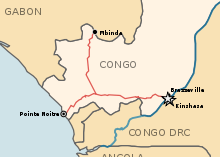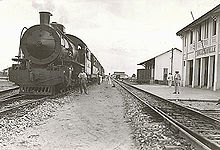- Congo–Ocean Railway
-
The Congo–Ocean Railway (COR; French: Chemin de fer Congo-Océan, CFCO) links the Atlantic port of Pointe-Noire (now in the Republic of Congo) with Brazzaville, a distance of 502 kilometres. It bypasses the rapids on the lower Congo River; from Brazzaville river boats are able to ascend the Congo River and its major tributaries, including the Oubangui River to Bangui.
Contents
Overview
The railway was constructed, starting in 1921, using forced labour, by the French colonial administration between 1924 and 1934, at a heavy cost in human lives. It has been estimated that 17,000 of the construction workers, who were mainly recruited from what is now southern Chad and the Central African Republic, died during the construction of the railway.[1] Other estimates were higher.
In 1962, a branch was constructed to Mbinda near the border with Gabon, to connect with the COMILOG Cableway and thus carry manganese ore to Pointe-Noire. The Cableway closed in 1986 when neighbouring Gabon built its own railway to haul this traffic. The branch line remains active nonetheless.
The Congo–Ocean Railway was a user of the Golwé locomotive. Motive power is now provided by diesel locomotives.
From the start of the civil war in 1997, the line was closed for six years. In 2007 the BBC reported it to be in a "decrepit state with the majority of trains now broken". UNICEF organised a train in August 2007 to distribute malaria nets vital in the prevention of the disease.[2] In 2007, a Korean led consortium CMKC Group signed a deal to build railway extensions to Ouesso and Djambala mainly for timber traffic. [3]
On 22 June 2010, a train of the Congo–Ocean Railroad was involved in a major incident, in which at least 60 people were killed. The train is believed to have derailed as it went round a corner in a remote area between Bilinga and Tchitondi, throwing four carriages into a ravine. The dead and wounded were taken to hospitals and morgues in Pointe-Noire.[4]
In 2011, it was announced that Africa Iron was close to concluding a 25-year ore transport deal with Congo–Ocean.[5]
Stations served
Congo–Ocean Railway
Chemin de fer Congo-OcéanLine length: 512 km / 318 mi Gauge: 1067 mm / 3 ft 6 in Legend


512 km Brazzaville 


Kikembo 


Ngoma-Tse-Tse 


Mayogongo 


Kibouende 


Ngabouloumou 


Madza 


Matoumbou 


Loualou 


Massembo-Loubaki 


Missafou 


Mindouli 


Kingoyi 


Kikembo 


Loulombo 


Kimbedi 


Loutété 


Bouansa 


Kipambou-Kayes 


Madingou 


Kimbaouka 


Bodissa 


Nkayu 


Moutela 


Loudima 


285 km Mbinda 


(Comilog-Line) 


0 km ? km Mont Bélo 


Moubotsi 


Tao-Tao 


? km 91 km Loubomo (Dolisie) 





Moukondo 


Mvouti 


Mpounga 


Malemba 


Les Saras 


Mfoubou 








Mvoungouti 


Nzombo 


Tsessi 


Tsoumbou 


Nemba 


Nkougni 





? km 0 km Bilinga 


Yanga 





Mboukou 


Makola 


Hinda 


Ntombo 


Ngondji 


0 km Pointe-Noire [6] Main article: Railway stations in CongoCOMILOG-Line Line length: 285 km / 177 mi Gauge: 1067 mm / 3 ft 6 in Legend


285 km Mbinda 


Ngongo 


Mayoko 


Tsinguidi 


Mbaka 


Vouka 


Nzima 


Moungoundou 


Moutebe 


Mossendjo 


Boungoto 


Massanga 


Tsimba 


Itsotso 


Titi 


Mabafi 


Mahitoula 


106 km PK 106 


Boudanga 


Makabana 


Moukanga 


Diesse 


Sinda 


Mouindi 


Kibouba 


512 km Brazzaville 


Loutété 


(Congo-Ocean) 


0 km Mont Bélo 


0 km Pointe-Noire 1 m[7] Specifications

- Rail gauge : 1,067 mm (3 ft 6 in) gauge (Jane's 69/70)
- Brake (railway): Vacuum brake (Jane's 69/70)
- Coupler: SA3 coupler (Jane's 69/70)
See also
- Congo Railway
- Matadi-Kinshasa Railway in the Democratic Republic of the Congo.
- Railway stations in Congo
References
- ^ "In pictures: Malaria train, Mayomba forest". news.bbc.co.uk. http://news.bbc.co.uk/2/shared/spl/hi/picture_gallery/07/africa_malaria_train/html/3.stm. Retrieved 2009-12-09.
- ^ "In pictures: Malaria train, Train engine". news.bbc.co.uk. http://news.bbc.co.uk/2/shared/spl/hi/picture_gallery/07/africa_malaria_train/html/1.stm. Retrieved 2009-12-09.
- ^ "Korea to build railroad in Congo". korea.net. http://www.korea.net/News/News/LangView.asp?serial_no=20070820016&lang_no=1&part=103&SearchDay=. Retrieved 2009-12-09.[dead link]
- ^ "60 reported dead in Congo train crash". Wikinews. 23 June 2010. http://en.wikinews.org/wiki/60_reported_dead_in_Congo_train_crash. Retrieved 23 June 2010.
- ^ "Railway Gazette: News in Brief". 2011-04-16. http://www.railwaygazette.com/nc/news/single-view/view/news-in-brief-52.html. Retrieved 2011-04-16.
- ^ http://www.cfco.cg/FileUpload/pics/Cartes/cfco_carte.jpg
- ^ http://www.cfco.cg/FileUpload/pics/Cartes/cfco_carte.jpg
- André Gide, Voyage au Congo (1926)
- Albert Londres, Terre d'Ébène (1929)
- Gilles Sautter, "Notes sur la construction du chemin de fer Congo-Océan (1921-1934)," Cahiers d'Études africaines 7:219-299 (1967)
- Jane's World Railways 69/70, pages 542/543

This Africa rail-related article is a stub. You can help Wikipedia by expanding it.


